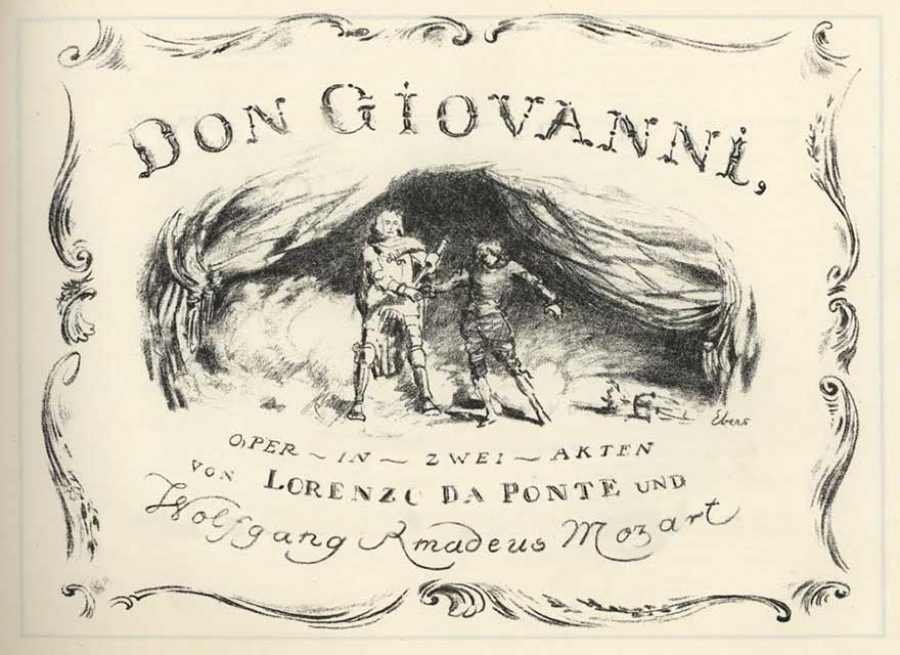The opera “Don Giovanni” was ordered after the great success of “Le nozze di Figaro” in Prague.
It is supposed that Lorenzo Da Ponte’s libretto was based on a libretto by Giovanni Bertati for the opera “Don Giovanni Tenorio” (to Giuseppe Gazzaniga’s music), which was performed in Venice in the beginning of 1787, although Da Ponte did not admit it. One of the most important elements, which he, it seems, borrowed, is the beginning of the drama with the murder of Il Commendatore (in the works written earlier this scene is situated in the middle).
The opera was finished on 28 or 29 October 1787. Known is the story about the written in the last moment overture. Some researchers assert that it was completed in the day before the premiere, and others – in the same day. More probable is the first theory, because Mozart put the date 28 October.
The premiere on 29 October 1787 in Prague was with the title “Il dissoluto punito, ossia il Don Giovanni” (“The Rake Punished, namely Don Giovanni” – dramma giocoso in two acts, and conductor was Mozart himself. The definition of the genre speaks about a synthesis between the serious opera seria and the comic opera buffa. The Prague audience was delighted. The biggest Prague newspaper wrote: “The connoisseurs and the musicians say that Prague has never heard something similar”, but marked also that “the opera is exceptionally difficult for performance”.
The premiere in Vienna on 7 May 1788 was again conducted by the composer. For the Vienna stage Mozart made several revisions. He wrote Don Ottavio’s aria “Dalla sua pace”, Elvira’s aria “In quali eccessi... Mi tradì quell'alma ingrata” and the duet of Leporello and Zerlina “Per queste tue manine”. He made several reductions in the finale, in order to make it shorter and more penetrating.
The musical images are bright, distinct and vivid. In the centre of the dramaturgy stands the character of Don Giovanni, and all other personages are characterized through their connection with him.
The overture is one of the biggest and most significant of Mozart’s overtures. It was written in the form of sonata allegro, in which alternate the heavy theme of Il Commendatore and the light melody, connected with the main character. This overture is one of the most often performed of Mozart’s orchestral works.
The opera begins with the appearance of the servant. Revolutionary for an age, in which the social stratification was clearly manifested, and Mozart did it also in “Le nozze di Figaro”. Especially interesting is the ensemble for three low voices: Don Giovanni, Il Commendatore and Leporello. Mozart follows the item structure and the ensembles and the arias are separated by the recitatives, which follow the speech intonation and are performed with the accompaniment of harpsichord. The arias, an absolute characteristic of the personages, are virtuoso and exceptionally complicated.
An outstanding musical achievement is the scene of the ball by Don Giovanni. In the orchestra are sounding three dances at the same time in a remarkable synchronicity. They are connected with the social status of each one of the characters. Relevantly the representatives of the aristocracy – Donna Anna, Donna Elvira, Don Ottavio and Don Giovanni are connected with the sounding minuet, and Zerlina and Masetto – with folk dances.
Key in dramaturgical aspect is the scene with the cemetery. Mozart uses with amazing mastery the timbres of the music instruments, the rhythmic and the nuances in the vocal parts. The merry story of Don Giovanni, accompanied by harpsichord, is interrupted by the voice of Il Commendatore, underlined by the sound of trombones in full contrast. Similar use of the orchestral panoply and introduction of the instrumental part as leading in the plot development is a real innovation. The finale is also divided in two sharply contrasting episodes – the dinner, accompanied by orchestra on the stage, and the dramatic culmination with the appearance of Il Commendatore and Don Giovanni’s death.
The second finale, which Mozart wrote, is tightly connected with the tradition of the comic opera from the age – the actors go out of the characters, in order to finish the work with the lesson drawn.
